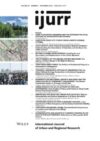Broken City blames the housing crises that afflict many metro areas entirely on land value speculation. Returning to the work of Henry George, author Patrick M. Condon contends that the public, rather than private owners, should capture the increase in land prices stimulated by economic growth and consequent population increases. He argues that value increments are not attributable to any investment by the landowners, but instead to improvements in the surroundings of their parcels. These improvements are themselves a consequence of both public infrastructure investment and the locational advantage that results from investment by other private development in the vicinity. Thus, for example, if employment grows because of an expanding economic base, more people will seek to live in the areas. In response, developers will build housing, but the price of the new housing will not result simply from the cost of construction but rather incorporates the price of the underlying land that has become more expensive due to increased demand for space. Condon sees the high cost of housing as a major driver of poverty and inequality, as households must shoulder a heavy rent burden that cuts into any resources they might have for food, health care and other necessities.
Condon is countering the mainstream view, promulgated by Harvard economist Edward Glaeser in popular media as well as technical papers, that blames housing shortages on regulations that restrict density and thus supply. The solution, then, in neoliberal economic logic, is deregulation that would allow the construction of multi-family residences. (This approach is embodied in New York City’s recently adopted ‘City of Yes’, which loosened height and density restrictions throughout the city.) Condon’s riposte to this argument is that increases in allowable density will succeed in only making land more valuable, since developers can make more profit from multiple occupancy structures.
Broken City is an excellent primer on the drivers of housing prices and strategies for reducing housing costs. After discarding regulatory restraints on supply as the main cause of the lack of affordable housing, Condon explains differentials in land prices by proximity to job sites and amenities. Rather than regarding segregation as a cause of pricing differences, he regards it as a consequence. But, as David Harvey and others have pointed out, the desirability of a home is determined by the people who live around it. Thus, we see centrally located neighborhoods where housing is relatively cheap and exurban ones that are very expensive.
Condon restricts his prescriptions to the prosperous English-speaking world, citing the political impossibility there of applying strategies like Singapore’s, which depend on public ownership of virtually all land on the island. He summarizes existing policies to promote affordable housing as working ‘either by withholding authorization for new projects that do not include affordable units or by offering additional development value in return for affordable housing concessions’ (p. 149). He refers to Vienna’s approach as providing a useful model to emulate. Vienna used rent control as a vehicle to diminish the cost of land by reducing its potential profitability. The government then purchased plots at low prices and passed ownership on to nonprofit housing associations, which charged rents only adequate to cover their operating expenses. While individual homeownership has increased in Vienna, social housing has been made sufficiently desirable to prevent soaring prices within the private market.
Although Condon has an extensive bibliography that covers the literature in real-estate economics, he makes no reference to the works focusing on spatial inequality by Henri Lefebvre, David Harvey, Neil Smith and their followers among urban geographers. Thus, he makes greater claims to originality than are warranted—his opening sentence calls urban land value ‘the largely unexamined cause of a lot of our current social justice and community health problems’. He briefly notes ongoing research by the Lincoln Institute of Land Policy, founded in 1946 to apply Georgist principles to affordability and public finance policies. Their work on community land trusts and Latin American methods of land value capture is particularly relevant to Condon’s concerns, and greater discussion of it would have helped to bolster his arguments. He also does not specifically cite tax increment financing (TIF), which has been used in some places to support affordable housing, although more often it has subsidized private commercial development.
Broken City makes useful proposals for efforts that would lead to more affordable housing, at the same time recognizing the political difficulty of achieving this goal within the context of societies where homeownership is both an ideal and the primary source of wealth for most households. The fact of widespread middle-class ownership means a large proportion of the public resists increases in property taxes and would oppose any measures likely to reduce not just the present value of their properties but also anticipated future growth. At the same time, increasing purchases of housing and mobile home communities by hedge funds has pushed up rental prices and prompted urban governments to respond through various measures of rent regulation and affordable housing requirements.
Broken City is a worthwhile contribution to the housing literature and highly suitable for class assignment. It is well written and shows clearly how unearned increments to land prices are a major propellant of the housing crisis. It perhaps minimizes the supply problem and failures to lower the costs of housing construction, but its thesis is generally sound and deserves reiterating.
Susan S. Fainstein, Harvard University
Patrick M. Condon 2024: Broken City: Land speculation, Inequality, and Urban Crisis. Vancouver, BC, UBC Press.
Views expressed in this section are independent and do not represent the opinion of the editors.

